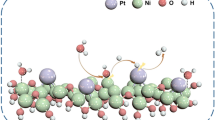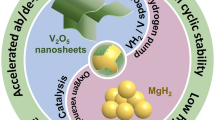Abstract
Ir-based electrocatalysts have been systematically studied for a variety of applications, among which the electrocatalysis for oxygen evolution reaction (OER) is one of the most prominent. The investigation on surface-microstructure- sensitive catalytic activity in different pH media is of great significance for developing efficient electrocatalysts and corresponding mechanism research. Herein, shape-tunable Ir-Pd alloy nanocrystals, including nano-hollow-spheres (NHSs), nanowires (NWs), and nanotetrahedrons (NTs), are synthesized via a facile one-pot solvothermal method. Electrochemical studies show that the OER activity of the Ir-Pd alloy nanocatalysts exhibits surface-microstructure-sensitive enhancement in acidic and alkaline media. Ir-Pd NWs and NTs show more than five times higher mass activity than commercial Ir/C catalyst at an overpotential of 0.25 V in acidic and alkaline media. Post-XPS analyses reveal that surface Ir(VI) oxide generated at surface defective sites of Ir-Pd nanocatalysts is a possible key intermediate for OER. In acidic medium, the specific activity of Ir-Pd nanocatalysts has a positive correlation with the surface roughness of NWs > NHSs > NTs. However, the strong dissociation of surface Ir(VI) species (IrO42-) at surface defective sites is a possible obstacle for the formation of Ir(VI) oxide, which reverses the activity sequence for OER in alkaline medium.
摘要
近年来铱基催化剂已经在一系列电催化反应中被广泛研究, 氧析出反应(OER)是其中最突出的代表. 研究不同pH介质中表面微观结构敏感的催化活性对于开发高效电催化剂及其反应机理研究具有重要意义. 本文作者通过简单的一步溶剂热法合成了纳米空心球(NHSs), 纳米线(NWs)和纳米四面体(NTs)等形貌可调的Ir-Pd合金纳米晶. 通过电化学研究表明, Ir-Pd合金纳米催化剂在酸性和碱性介质中的OER活性增强表现出表面微结构敏感性. Ir-Pd NWs和NTs在酸性和碱性介质中0.25 V过电势下表现出商业Ir/C催化剂五倍以上的质量活性. XPS结果表明, 在Ir-Pd纳米催化剂表面缺陷位置产生的Ir(VI)物种可能是反应中的一种关键中间体. 在酸性介质中, Ir-Pd纳米催化剂的比活性与Ir-Pd纳米催化剂表面粗糙度呈正相关, 即NWs > NHSs > NTs. 而碱性介质中由于位于表面缺陷位点的IrO42-物种快速分解阻碍了Ir(VI)物种的形成, 改变了Ir-Pd纳米催化剂的OER活性顺序.
Similar content being viewed by others
References
Giménez S, Bisquert J. Photoelectrochemical Solar Fuel Production. Heidelberg: Springer, 2016
Hosseini SE, Wahid MA. Hydrogen production from renewable and sustainable energy resources: Promising green energy carrier for clean development. Renew Sustain Energ Rev, 2016, 57: 850–866
Carmo M, Fritz DL, Mergel J, et al. A comprehensive review on PEM water electrolysis. Int J Hydrogen Energ, 2013, 38: 4901–4934
Katsounaros I, Cherevko S, Zeradjanin AR, et al. Oxygen electrochemistry as a cornerstone for sustainable energy conversion. Angew Chem Int Ed, 2014, 53: 102–121
Antolini E. Iridium as catalyst and cocatalyst for oxygen evolution/reduction in acidic polymer electrolyte membrane electrolyzers and fuel cells. ACS Catal, 2014, 4: 1426–1440
Reier T, Oezaslan M, Strasser P. Electrocatalytic oxygen evolution reaction (OER) on Ru, Ir, and Pt catalysts: a comparative study of nanoparticles and bulk materials. ACS Catal, 2012, 2: 1765–1772
McCrory CCL, Jung S, Peters JC, et al. Benchmarking heterogeneous electrocatalysts for the oxygen evolution reaction. J Am Chem Soc, 2013, 135: 16977–16987
Lettenmeier P, Wang L, Golla-Schindler U, et al. Nanosized IrOx-Ir catalyst with relevant activity for anodes of proton exchange membrane electrolysis produced by a cost-effective procedure. Angew Chem Int Ed, 2016, 55: 742–746
Oh HS, Nong HN, Reier T, et al. Electrochemical catalyst–support effects and their stabilizing role for IrOx nanoparticle catalysts during the oxygen evolution reaction. J Am Chem Soc, 2016, 138: 12552–12563
Seitz LC, Dickens CF, Nishio K, et al. A highly active and stable IrOx/SrIrO3 catalyst for the oxygen evolution reaction. Science, 2016, 353: 1011–1014
Pi Y, Zhang N, Guo S, et al. Ultrathin laminar Ir superstructure as highly efficient oxygen evolution electrocatalyst in broad PH range. Nano Lett, 2016, 16: 4424–4430
Alia SM, Rasimick B, Ngo C, et al. Activity and durability of iridium nanoparticles in the oxygen evolution reaction. J Electrochem Soc, 2016, 163: F3105–F3112
Danilovic N, Subbaraman R, Chang KC, et al. Using surface segregation to design stable Ru-Ir oxides for the oxygen evolution reaction in acidic environments. Angew Chem Int Ed, 2014, 53: 14016–14021
Reier T, Pawolek Z, Cherevko S, et al. Molecular insight in structure and activity of highly efficient, low-Ir Ir–Ni oxide catalysts for electrochemical water splitting (OER). J Am Chem Soc, 2015, 137: 13031–13040
Zhang T, Li SC, Zhu W, et al. Shape-tunable Pt–Ir alloy nanocatalysts with high performance in oxygen electrode reactions. Nanoscale, 2017, 9: 1154–1165
Nong HN, Oh HS, Reier T, et al. Oxide-supported IrNiOx coreshell particles as efficient, cost-effective, and stable catalysts for electrochemical water splitting. Angew Chem Int Ed, 2015, 54: 2975–2979
Hodgson A, Haq S. Water adsorption and the wetting of metal surfaces. Surf Sci Rep, 2009, 64: 381–451
Peköz R, Wörner S, Ghiringhelli LM, et al. Trends in the adsorption and dissociation of water clusters on flat and stepped metallic surfaces. J Phys Chem C, 2014, 118: 29990–29998
Jiang Z, Li L, Li M, et al. Density functional theory study on the adsorption and decomposition of H2O on clean and oxygenmodified Pd (100) surface. Appl Surf Sci, 2014, 301: 468–474
Kolb B, Müller S, Botts DB, et al. Ordering tendencies in the binary alloys of Rh, Pd, Ir, and Pt: density functional calculations. Phys Rev B, 2006, 74: 144206
Turchi PEA, Drchal V, Kudrnovský J. Stability and ordering properties of fcc alloys based on Rh, Ir, Pd, and Pt. Phys Rev B, 2006, 74: 064202
Nakagawa Y, Takada K, Tamura M, et al. Total hydrogenation of furfural and 5-hydroxymethylfurfural over supported Pd–Ir alloy catalyst. ACS Catal, 2014, 4: 2718–2726
Yang H, Huang C, Yang F, et al. Mesoporous silica nanoparticle supported PdIr bimetal catalyst for selective hydrogenation, and the significant promotional effect of Ir. Appl Surf Sci, 2015, 357: 558–563
Liu M, Zheng Y, Xie S, et al. Facile synthesis of Pd–Ir bimetallic octapods and nanocages through galvanic replacement and coreduction, and their use for hydrazine decomposition. Phys Chem Chem Phys, 2013, 15: 11822–11829
Xia X, Figueroa-Cosme L, Tao J, et al. Facile synthesis of iridium nanocrystals with well-controlled facets using seed-mediated growth. J Am Chem Soc, 2014, 136: 10878–10881
Assumpção MHMT, da Silva SG, De Souza RFB, et al. Investigation of PdIr/C electrocatalysts as anode on the performance of direct ammonia fuel cell. J Power Sources, 2014, 268: 129–136
Adams BD, Asmussen RM, Ostrom CK, et al. Synthesis and comparative study of nanoporous palladium-based bimetallic catalysts for formic acid oxidation. J Phys Chem C, 2014, 118: 29903–29910
Hao Y, Shen J, Wang X, et al. Facile preparation of PdIr alloy nano-electrocatalysts supported on carbon nanotubes, and their enhanced performance in the electro-oxidation of formic acid. Int J Hydrogen Energ, 2016, 41: 3015–3022
Yang T, Ma Y, Huang Q, et al. Palladium–iridium nanocrystals for enhancement of electrocatalytic activity toward oxygen reduction reaction. Nano Energ, 2016, 19: 257–268
Lee Y, Suntivich J, May KJ, et al. Synthesis and activities of rutile IrO2 and RuO2 nanoparticles for oxygen evolution in acid and alkaline solutions. J Phys Chem Lett, 2012, 3: 399–404
Cherevko S, Geiger S, Kasian O, et al. Oxygen and hydrogen evolution reactions on Ru, RuO2, Ir, and IrO2 thin film electrodes in acidic and alkaline electrolytes: a comparative study on activity and stability. Catal Today, 2016, 262: 170–180
Huang X, Zhang H, Guo C, et al. Simplifying the creation of hollow metallic nanostructures: one-pot synthesis of hollow palladium/platinum single-crystalline nanocubes. Angew Chem Int Ed, 2009, 48: 4808–4812
Wang SB, Zhu W, Ke J, et al. Pd–Rh nanocrystals with tunable morphologies and compositions as efficient catalysts toward Suzuki cross-coupling reactions. ACS Catal, 2014, 4: 2298–2306
Zhang T, Li SC, Zhu W, et al. Iridium ultrasmall nanoparticles, worm-like chain nanowires, and porous nanodendrites: One-pot solvothermal synthesis and catalytic CO oxidation activity. Surf Sci, 2016, 648: 319–327
Yin AX, Min XQ, Zhang YW, et al. Shape-selective synthesis and facet-dependent enhanced electrocatalytic activity and durability of monodisperse sub-10 nm Pt-Pd tetrahedrons and cubes. J Am Chem Soc, 2011, 133: 3816–3819
Moulder JF, Chastain J. Handbook of X-ray Photoelectron Spectroscopy: A Reference Book of Standard Spectra for Identification and Interpretation of XPS Data. Ismaning: Physical Electronics, 1995
Crist BV. Handbooks of Monochromatic XPS Spectra. Kawasaki: XPS International, 1999
Riley AE, Tolbert SH. Synthesis of periodic hexagonal surfactant templated platinum tin tellurides: narrow band gap inorganic/organic composites. J Am Chem Soc, 2003, 125: 4551–4559
Miller DJ, Öberg H, Kaya S, et al. Oxidation of Pt(111) under nearambient conditions. Phys Rev Lett, 2011, 107: 195502
Hillman AR, Skopek MA, Gurman SJ. X-ray spectroscopy of electrochemically deposited iridium oxide films: detection of multiple sites through structural disorder. Phys Chem Chem Phys, 2011, 13: 5252–5263
Sanchez Casalongue HG, Ng ML, Kaya S, et al. In situ observation of surface species on iridium oxide nanoparticles during the oxygen evolution reaction. Angew Chem Int Ed, 2014, 53: 7169–7172
McCrory CCL, Jung S, Ferrer IM, et al. Benchmarking hydrogen evolving reaction and oxygen evolving reaction electrocatalysts for solar water splitting devices. J Am Chem Soc, 2015, 137: 4347–4357
Benck JD, Chen Z, Kuritzky LY, et al. Amorphous molybdenum sulfide catalysts for electrochemical hydrogen production: insights into the origin of their catalytic activity. ACS Catal, 2012, 2: 1916–1923
Park S, Shao Y, Liu J, et al. Oxygen electrocatalysts for water electrolyzers and reversible fuel cells: status and perspective. Energ Environ Sci, 2012, 5: 9331
Tsuji E, Imanishi A, Fukui K, et al. Electrocatalytic activity of amorphous RuO2 electrode for oxygen evolution in an aqueous solution. Electrochim Acta, 2011, 56: 2009–2016
Ye ZG, Meng HM, Chen D, et al. Structure and characteristics of Ti/IrO2(x)+MnO2(1-x) anode for oxygen evolution. Solid State Sci, 2008, 10: 346–354
Suen NT, Hung SF, Quan Q, et al. Electrocatalysis for the oxygen evolution reaction: recent development and future perspectives. Chem Soc Rev, 2017, 46: 337–365
Cherevko S, Reier T, Zeradjanin AR, et al. Stability of nanostructured iridium oxide electrocatalysts during oxygen evolution reaction in acidic environment. Electrochem Commun, 2014, 48: 81–85
Cherevko S, Geiger S, Kasian O, et al. Oxygen evolution activity and stability of iridium in acidic media. Part 1.–metallic iridium. J Electroanal Chem, 2016, 773: 69–78
Cherevko S, Geiger S, Kasian O, et al. Oxygen evolution activity and stability of iridium in acidic media. Part 2.–electrochemically grown hydrous iridium oxide. J Electroanal Chem, 2016, 774: 102–110
Lee YP, Lin KL, Lee JT. Electrochemical and corrosion behaviour of iridium-palladium oxide electrode prepared by electrochemical methods. Corrosion Sci, 1993, 35: 387–394
Mo Y, Stefan IC, Cai WB, et al. In situ iridium LIII-edge X-ray absorption and surface enhanced raman spectroscopy of electrodeposited iridium oxide films in aqueous electrolytes. J Phys Chem B, 2002, 106: 3681–3686
Reier T, Nong HN, Teschner D, et al. Electrocatalytic oxygen evolution reaction in acidic environments–reaction mechanisms and catalysts. Adv Energ Mater, 2017, 7: 1601275
Pourbaix M. Atlas of Electrochemical Equilibria in Aqueous Solutions. Oxford: Pergamon, 1966
Lu Z, Wang H, Kong D, et al. Electrochemical tuning of layered lithium transition metal oxides for improvement of oxygen evolution reaction. Nat Commun, 2014, 5: 4345
Acknowledgements
This work was supported by the National Natural Science Foundation of China (21573005, 21771009 and 21621061), the National Key Research and Development Program (2016YFB0701100) and Beijing Natural Science Foundation (2162019).
Author information
Authors and Affiliations
Corresponding author
Additional information
Tao Zhang received his PhD degree in 2017 from the College of Chemistry and Molecular Engineering, Peking University. He is currently a postdoctoral fellow at the Sinopec Shanghai Research Institute of Petrochemical Technology. His research interest focuses on the synthesis and catalytic properties of functional nanomaterials.
Si-An Liao received his BSc degree in 2017 from the College of Chemistry and Molecular Engineering, Peking University. He is currently a PhD candidate at the Department of Chemistry, Brown University.
Ya-Wen Zhang is currently a professor and principle investigator at the College of Chemistry and Molecular Engineering, Peking University. His research interest lies in the rational design, controllable synthesis, ordered assembly, catalytic properties and structure-function relationships of rare earth & noble metal nanostructures. He has published more than 130 papers in peer-reviewed scientific journals with total citations over 10,000.
Electronic supplementary material
40843_2017_9187_MOESM1_ESM.pdf
Ir-Pd Nanoalloys with Enhanced Surface-Microstructure-Sensitive Catalytic Activity for Oxygen Evolution Reaction in Acidic and Alkaline Media
Rights and permissions
About this article
Cite this article
Zhang, T., Liao, SA., Dai, LX. et al. Ir-Pd nanoalloys with enhanced surface-microstructure-sensitive catalytic activity for oxygen evolution reaction in acidic and alkaline media. Sci. China Mater. 61, 926–938 (2018). https://doi.org/10.1007/s40843-017-9187-1
Received:
Accepted:
Published:
Issue Date:
DOI: https://doi.org/10.1007/s40843-017-9187-1




